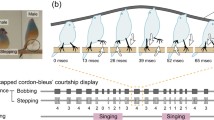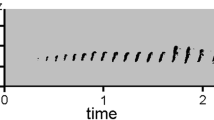Summary
The loud and elaborate songs of male songbirds are throught to serve in territorial defense and to stimulate reproductive behavior in the female. We report here that in contrast to several other species, song alone is inadequate to induce sexual (lordosis) behavior in female indigo and lazuli buntings (Passerina cyanea and P. amoena); they require a more elaborate stimulus configuration to develop the full expression of sexual receptivity as indicated by a stereotyped copulation solicitation display. A live male must be present near the female, singing must ensue, and in addition a second and unique vocal utterance must be heard by the female; this is a soft buzzy-sounding vocalization, audible for no more than a few meters, not recognized previously as a critical arousal signal of the male songbird repertoire. Females also utter similar soft sounds in an intimate vocal exchange with the male leading to solicitation of copulation.
Similar content being viewed by others
References
Adler NT (1981) Neuroendocrinology of reproduction. Plenum Press, New York
Altum B (1869) Der Vogel und Sein Leben. Niemann, Münster
Baker MC (1983) The behavioral response of female Nuttall's white-crowned sparrows to male song of natal and alien dialects. Behav Ecol Sociobiol 12:309–315
Baker MC, Bjerke TK, Lampe HM, Espmark YO (1986) Sexual response of female great tits to variation in size of males' repertoires. Am Nat 128:491–498
Baker MC, Bjerke TK, Lampe HM, Espmark YO (1987) Sexual response of female yellowhammers to differences in regional song dialects and repertoire sizes. Anim Behav 35:395–401
Baker MC, Spitler-Nabors KJ, Bradley DC (1981) Early experience determines dialect responsiveness of female sparrows. Science 214:819–821
Baker MC, McGregor PK, Krebs JR (1987) Sexual response of female great tits to local and distant songs. Ornis Scand 18:186–188
Baker MC, Spitler-Nabors KJ, Thompson AD Jr, Cunningham MA (1987) Reproductive behaviour of female white-crowned sparrows: effect of dialects and synthetic hybrid songs. Anim Behav 35:1766–1774
Catchpole CK, Dittami J, Leisler B (1984) Differential responses to male song repertoires in female songbirds implanted with oestradiol. Nature 312:563–564
Cheng M-F (1979) Progress and prospect in ring dove research: a personal view. In: Rosenblatt JS, Hinde RA, Beer CG, Busnel M-C (eds) Advances in the study of behavior, vol 9. Academic Press, London New York, pp 97–129
Cheng M-F (1986) Female cooing promotes ovarian development in ring doves. Physiology & Behavior 37:371–374
Crews D, Moore MC (1986) Evolution of mechanisms controlling mating behavior. Science 231:121–125
Darwin C (1871) The descent of man and selection in relation to sex. Murray, London
Eastzer DH, King AP, West MJ (1985) Patterns of courtship between cowbird subspecies: evidence for positive assortment. Anim Behav 33:30–39
Eriksson D, Wallin L (1986) Male bird song attracts females — a field experiment. Behav Ecol Sociobiol 19:297–299
Falls JB (1978) Bird song and territorial behavior. In: Kramer L, Pliner P, Alloway T (eds) Aggression, dominance and individual spacing in the study of communication and affect, vol 4. Plenum Press, New York, pp 61–89
Floody OR, Pfaff DW (1977) Communication among hamsters by high-frequency acoustic signals: III. Responses evoked by natural and synthetic ultrasounds. J Comp Physiol Psychol 91:820–829
Floody OR, Pfaff DW, Lewis CD (1977) Communication among hamsters by high-frequency acoustic signals: II. Determinants of calling by females. J Comp Physiol Psychol 91:807–819
Gibson RM, Bradbury JW (1985) Sexual selection in lekking sage grouse: phenotypic correlates of male mating success. Behav Ecol Sociobiol 18:117–123
King AP, West MJ (1984) Social metrics of song learning. Learning and Motivation 15:441–458
Krebs JR, Avery M, Cowie J (1981) Effect of removal of mate on the singing behaviour of great tits. Anim Behav 29:635–637
McClintock MK (1987) A functional approach to the behavioral endocrinology of rodents. In: Crews D (ed) Psychobiology of reproductive behavior, an evolutionary perspective. Prentice-Hall, Englewood Cliffs, pp 176–203
McIntosh TK, Barfield RJ, Geyer LA (1978) Ultrasonic vocalisations facilitate sexual behaviour of female rat. Nature 272:163–164
Pfaff DW (1980) Estrogens and brain function. Springer, Berlin Heidelberg New York
Searcy WA (1984) Song repertoire size and female preferences in song sparrows. Behav Ecol Sociobiol 14:281–286
Searcy WA, Marler P (1981) A test of responsiveness to song structure and programming in female sparrows. Science 213:926–928
Searcy WA, Marler P (1984) Interspecific differences in the response of female birds to song repertoires. Z Tierpsychol 66:128–142
Sokal RR, Rohlf FJ (1981) Biometry. Freeman & Co, San Francisco
Spitler-Nabors KJ, Baker MC (1987) Sexual display response of female white-crowned sparrows to normal, isolate and modified conspecific songs. Anim Behav 35:380–386
Thomas DA, Barfield RJ (1985) Ultrasonic vocalization of the female rate (Rattus norvegicus) during mating. Anim Behav 33:720–725
Thomas DA, Talalas L, Barfield RJ (1981) Effect of devocalization of the male on mating behavior in rats. J Comp Physiol Psychol 95:630–637
Thompson WL (1968) The songs of five species of Passerina. Behaviour 31:261–287
Thompson WL (1976) Vocalizations of the lazuli bunting. Condor 78:195–207
Thompson WL, Rice JO (1970) Calls of the indigo bunting, Passerina cyanea. Z. Tierpsychol 27:35–46
Wasserman FE (1977) Mate attraction function of song in the white-throated sparrow. Condor 79:125–127
Yasukawa K (1981) Male quality and female choice of mate in the red-winged blackbird (Agelaius phoeniceus). Ecology 62:922–929
Author information
Authors and Affiliations
Rights and permissions
About this article
Cite this article
Baker, M.C., Baker, A.E.M. Vocal and visual stimuli enabling copulation behavior in female buntings. Behav Ecol Sociobiol 23, 105–108 (1988). https://doi.org/10.1007/BF00299893
Received:
Accepted:
Issue Date:
DOI: https://doi.org/10.1007/BF00299893




